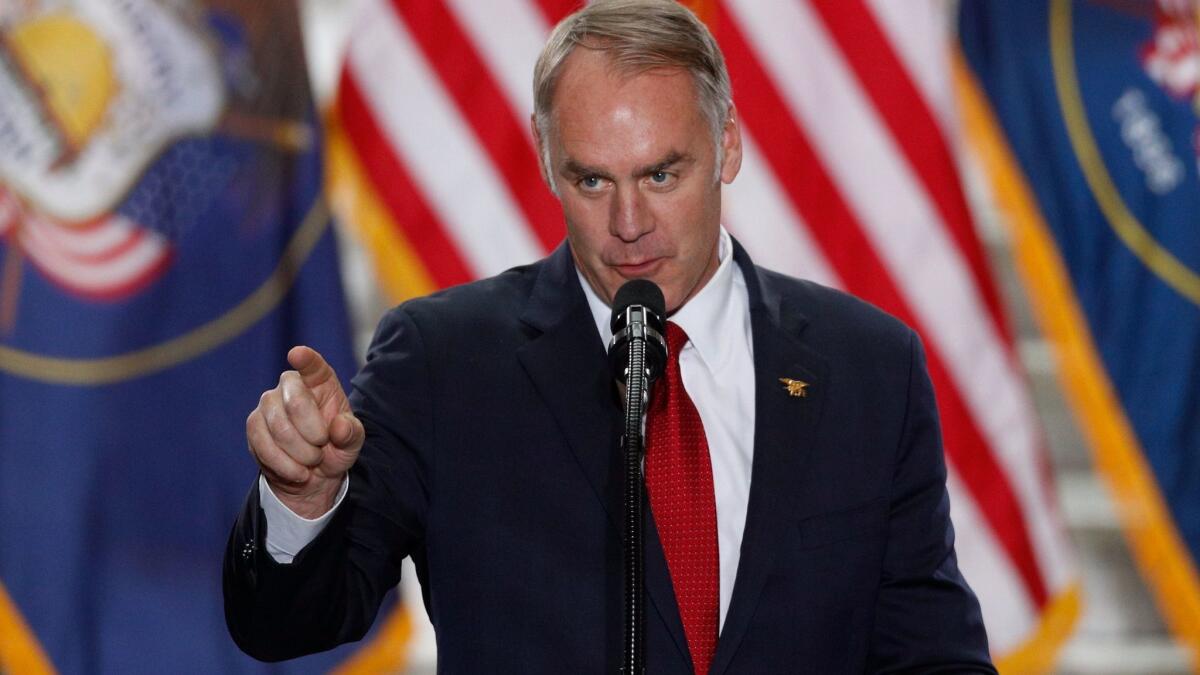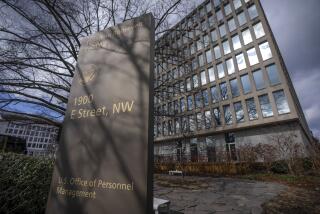Spread the swamp? Trump administration wants to move government offices out of Washington

Reporting from Washington — Amid the talk of draining swamps, restoring political might to blue-collar America and turning off the spigot of taxpayer cash that showers Washington, a familiar battle cry is ricocheting through this city: Move the bureaucrats out.
It has the ring of a Trumpian fantasy. Dislodge arms of the federal government from Washington and reattach them in faraway places, spreading the wealth generated by these well-paid agency workforces and forcing senior bureaucrats to face the people they affect.
But the idea has established populist roots that spread across party lines, and they are reemerging at this unique political moment.
The swaggering Interior secretary from Montana is putting the finishing touches on his plan to move the headquarters of three large public lands agencies to the West. The Stanford economist representing Silicon Valley in Congress sees opportunity to strategically seed regions of the country with pieces of the federal bureaucracy that can benefit them — and that they can benefit. The unlikely prospect of locating the Department of Transportation in Los Angeles is dangled by Republicans eager to show this crusade has bipartisan cred.
There hasn’t been so much buzz about getting “Washington” out of Washington since Franklin D. Roosevelt sent 30,000 federal workers to the Midwest after a presidential commission advised such moves would ensure the prototypical federal employee “remains one of the people in touch with the people and does not degenerate into an isolated and arrogant bureaucrat.”
“We need to find out what we can move,” said Rep. Tim Ryan, a Democrat from Youngstown, Ohio, who is seeking to create a commission that would identify parts of the bureaucracy that could be moved to economically distressed regions like his. A fellow Ohio congressman and political rival, tea party activist Warren Davidson, has mounted a parallel bureaucracy migration push. He calls it the “Drain the Swamp Act.”
None of it is going over well with die-hard Washingtonians. Many scold that the idea will flame out the same way it did when the Clinton administration pondered and then dropped a big relocation initiative, and the Reagan administration did the same before it.
When the House Oversight and Government Reform Committee passed a “Divest D.C.” resolution this year that calls on all agencies to investigate moving out, Eleanor Holmes Norton, the nonvoting House representative for Washington, warned that it would cost taxpayers a fortune, spread dysfunction throughout the bureaucracy and economically devastate the region.
Her Democratic allies on the committee were not impressed by the suggestion of the measure’s sponsor, former Rep. Jason Chaffetz (R-Utah), that maybe it could lead to the Department of Transportation moving to the traffic capital of the nation, liberal Los Angeles.
Other Democrats, though, are intrigued by the possibilities of a redistributed bureaucracy.
“There is a lot of wisdom outside the Beltway,” said Rep. Ro Khanna, the Silicon Valley Democrat. He wants agencies to more aggressively tap into it, as the Defense Department did when it set up a shop in Silicon Valley. Khanna, a Stanford economist, is among several in Washington’s intellectual circles who say fading factory and farm towns are well positioned to benefit from the kind of relocations envisioned in plans like Ryan’s.
There are other reasons the movement has regained steam of late. Although only 15% of the federal workforce is in Washington, it is where most of the top decision makers live and work. David Fontana, a professor at George Washington University Law School who is writing a book about decentralizing the federal government, says their bubble is growing evermore insulated from reality.
“When you have this concentration of important people all in a single place, they form their own tight networks immune to other influences,” he said. Decentralizing that power away from the capital has long been a trend in other countries, Fontana said. “This is not a crazy idea.”
The Trump administration will probably put it to the test soon. Interior Secretary Ryan Zinke, a Montanan, is aiming to move the headquarters of the Bureau of Land Management, the Fish and Wildlife Service and the Bureau of Reclamation out of Washington as soon as logistically possible. Western politicians like Sen. Corey Gardner (R-Colo.) are cheering him on.
“Ninety-nine percent of the nearly 250 million acres of land managed by BLM is west of the Mississippi River, and having the decision makers present in the communities they impact in Colorado or across the region will lead to better results,” Gardner wrote in an email. He wants the bureau headquartered in his state, and Colorado’s Democratic governor, John Hickenlooper, has joined Gardner’s lobbying campaign.
House Natural Resources Committee Chairman Rob Bishop (R-Utah), who held a hearing Thursday to examine Zinke’s plan, said in an interview that his constituents are so distrustful of what they see as a heavy-handed National Park Service that he had to abandon his plan to elevate Dinosaur National Monument to a national park, a move that he hoped would lure a world-class research center to the state and boost tourism. He’s hopeful Zinke’s blueprint would ultimately ease those tensions by bringing more public lands management out west.
Some Democrats, though, see a sham at a time Zinke has also been unabashed about his plans to shrink the Interior Department’s workforce, which includes pushing workers out by relocating them. “This reorganization is an exercise in weakening the Department of Interior by driving employees out,” said Rep. Raul M. Grijalva (D-Ariz.). “Once they’re gone, the extractive industries will be able to check off the top item on their wish list” — getting the stewards of public land out of their way.
A lot of the broader relocation debate is familiar. And some scholars project that though a few hundred jobs might get moved here or there, the broader vision of moving large pieces of Washington officialdom hundreds or thousands of miles away will end up in the shredder, as tends to happen with outsize plans to reinvent and reimagine government. The politics are messy, the logistics are tough, and the status quo is entrenched.
“While this has perennial appeal, it is hard to pull off,” said Andrew Rudalevige, a professor of government at Bowdoin College in Maine.
There is also the danger that it could create problems instead of solving them. Matt Lee-Ashley, a public lands expert at the liberal Center for American Progress, warns that accountability is undermined when agencies move away from the lawmakers and federal investigators who watch over them. He points to the scandal that enveloped the Minerals Management Service during the administration of George W. Bush. It had been set up in suburban Denver with a mandate to conduct the business of collecting $10 billion in royalties like a private company. It turned into a cesspool of corruption and bad behavior, according to federal investigators.
Of course, the argument that Washington is the cure for corruption and bad behavior can be a tough one to make. And the headaches and expense of shoehorning so many agency headquarters into this costly, congested town keep growing.
The projected costs of a new FBI headquarters in suburban Washington escalated until they hit close to $2 billion. The whole project was canceled over the summer amid the rising price and difficulties pulling off the land swap it was designed around.
“There is all this unused office space outside of Detroit where the FBI could build for not much money,” said Paul Kupiec, a scholar at the right-leaning American Enterprise Institute. That city, unlike suburban Washington, desperately needs the economic surge such an agency would bring, he said. “Why are we spending billions of dollars on these headquarters in Washington?”
Follow me: @evanhalper
More to Read
Get the L.A. Times Politics newsletter
Deeply reported insights into legislation, politics and policy from Sacramento, Washington and beyond. In your inbox three times per week.
You may occasionally receive promotional content from the Los Angeles Times.











